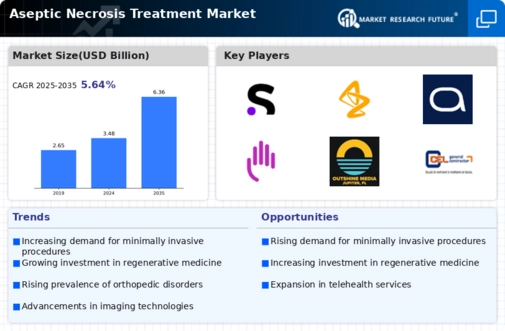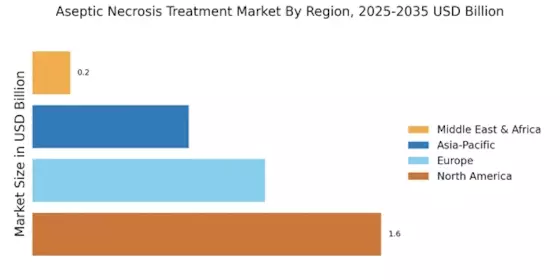Rising Awareness and Education
Increased awareness and education regarding aseptic necrosis among healthcare professionals and patients are pivotal in shaping the Aseptic Necrosis Treatment Market. As more individuals become informed about the symptoms and potential complications of the condition, there is a growing demand for timely diagnosis and intervention. Healthcare providers are increasingly focusing on educating patients about risk factors and treatment options, which is likely to lead to earlier detection and improved management of the disease. This heightened awareness is also fostering a more proactive approach to treatment, encouraging patients to seek medical advice sooner. Consequently, this trend is expected to stimulate market growth as more individuals pursue effective treatment solutions.
Advancements in Medical Technology
Technological advancements in medical devices and treatment methodologies are significantly influencing the Aseptic Necrosis Treatment Market. Innovations such as improved imaging techniques, minimally invasive surgical tools, and enhanced biomaterials for implants are transforming the landscape of treatment options. For instance, the introduction of advanced arthroscopic techniques allows for more precise interventions, reducing recovery times and improving patient outcomes. Furthermore, the market is witnessing a surge in the development of regenerative medicine approaches, including stem cell therapies, which show promise in repairing damaged bone tissue. These advancements not only enhance the efficacy of treatments but also attract investment from stakeholders eager to capitalize on emerging technologies, thereby driving market growth.
Government Initiatives and Funding
Government initiatives aimed at improving healthcare access and funding for research into bone-related diseases are crucial drivers of the Aseptic Necrosis Treatment Market. Various governments are recognizing the need to address the burden of aseptic necrosis and are allocating resources to support research and development in this area. For instance, funding programs for clinical trials and innovative treatment solutions are being established, which may lead to the discovery of new therapies and improved patient care. Additionally, public health campaigns aimed at educating the population about bone health and preventive measures are likely to enhance early diagnosis and treatment uptake. Such initiatives not only bolster the market but also contribute to the overall improvement of healthcare systems.
Growing Demand for Personalized Medicine
The shift towards personalized medicine is becoming increasingly relevant in the Aseptic Necrosis Treatment Market. As healthcare evolves, there is a growing recognition that treatment approaches should be tailored to individual patient needs, particularly in complex conditions like aseptic necrosis. Advances in genetic testing and biomarker identification are enabling healthcare providers to develop customized treatment plans that consider a patient's unique genetic makeup and lifestyle factors. This trend is likely to enhance treatment efficacy and patient satisfaction, as personalized approaches can lead to better outcomes. Consequently, the demand for personalized treatment options is expected to drive innovation and investment in the market, as stakeholders seek to meet the evolving needs of patients.
Increasing Incidence of Aseptic Necrosis
The rising incidence of aseptic necrosis, particularly among the aging population, is a primary driver for the Aseptic Necrosis Treatment Market. Studies indicate that the prevalence of this condition is increasing, with estimates suggesting that approximately 10,000 new cases arise annually in various regions. This trend is likely attributed to factors such as lifestyle changes, increased obesity rates, and prolonged use of corticosteroids, which are known risk factors. As the population ages, the demand for effective treatment options is expected to grow, prompting healthcare providers to seek innovative solutions. Consequently, pharmaceutical companies and medical device manufacturers are investing in research and development to address this pressing need, thereby propelling the market forward.


















Leave a Comment